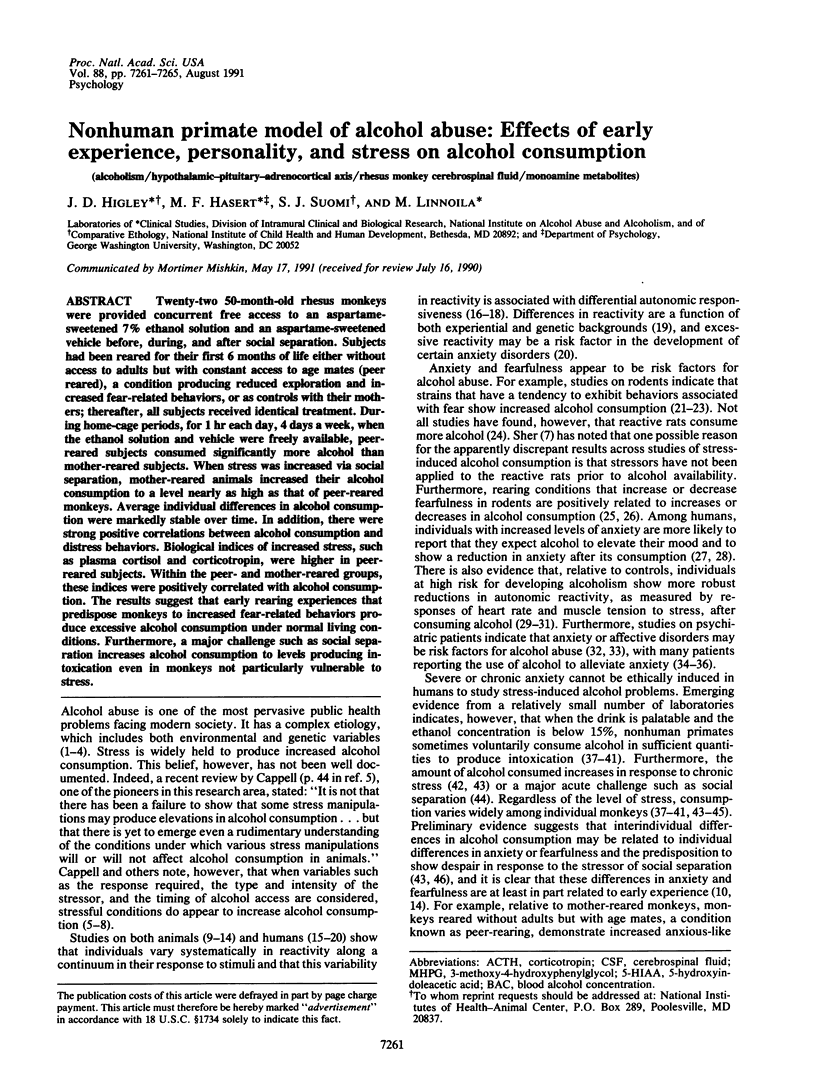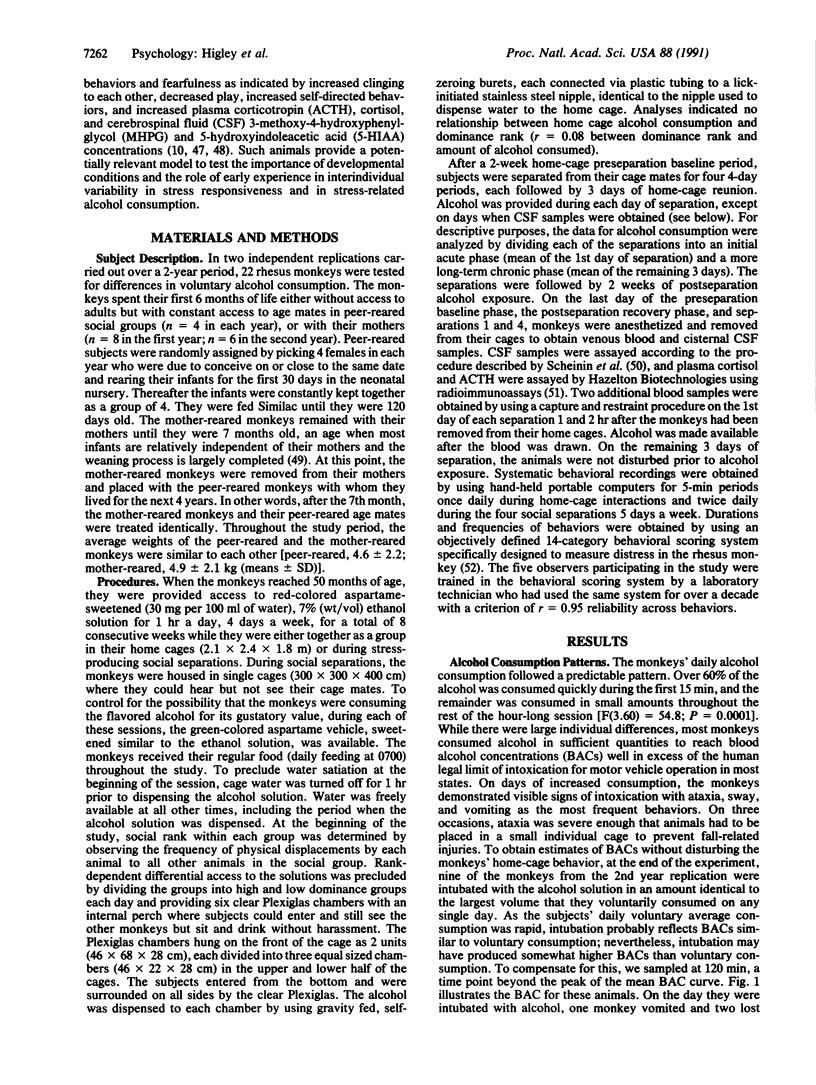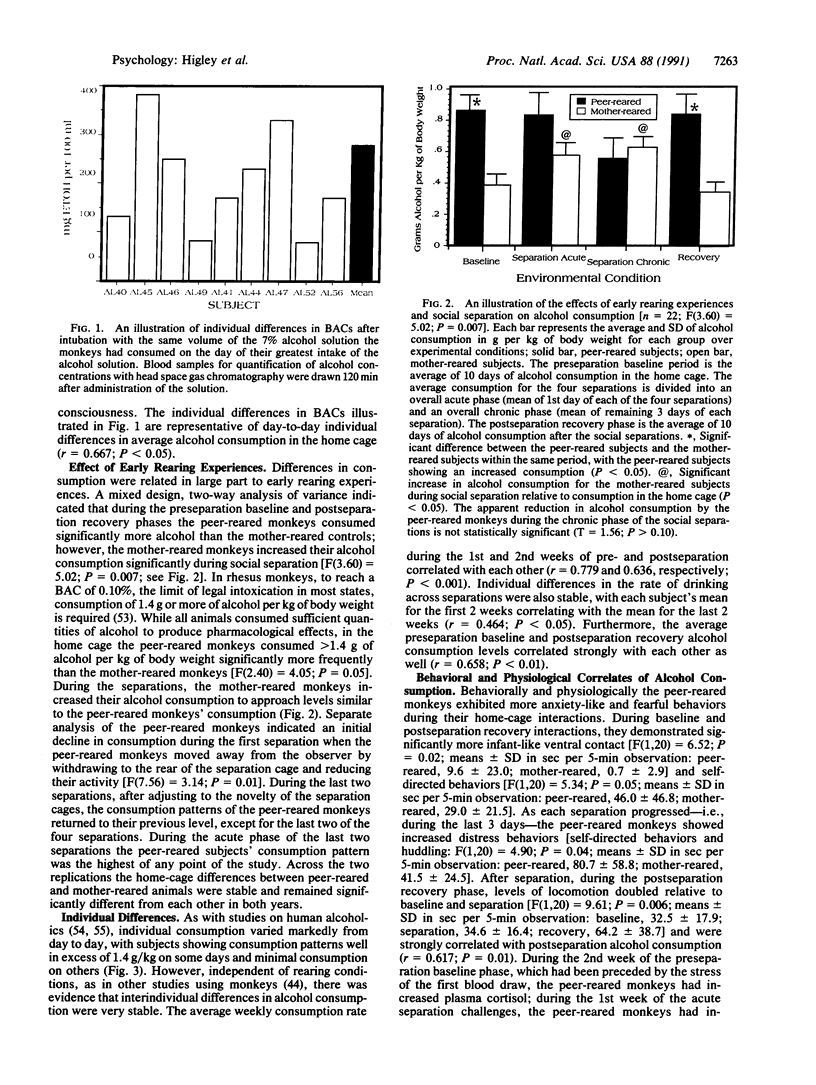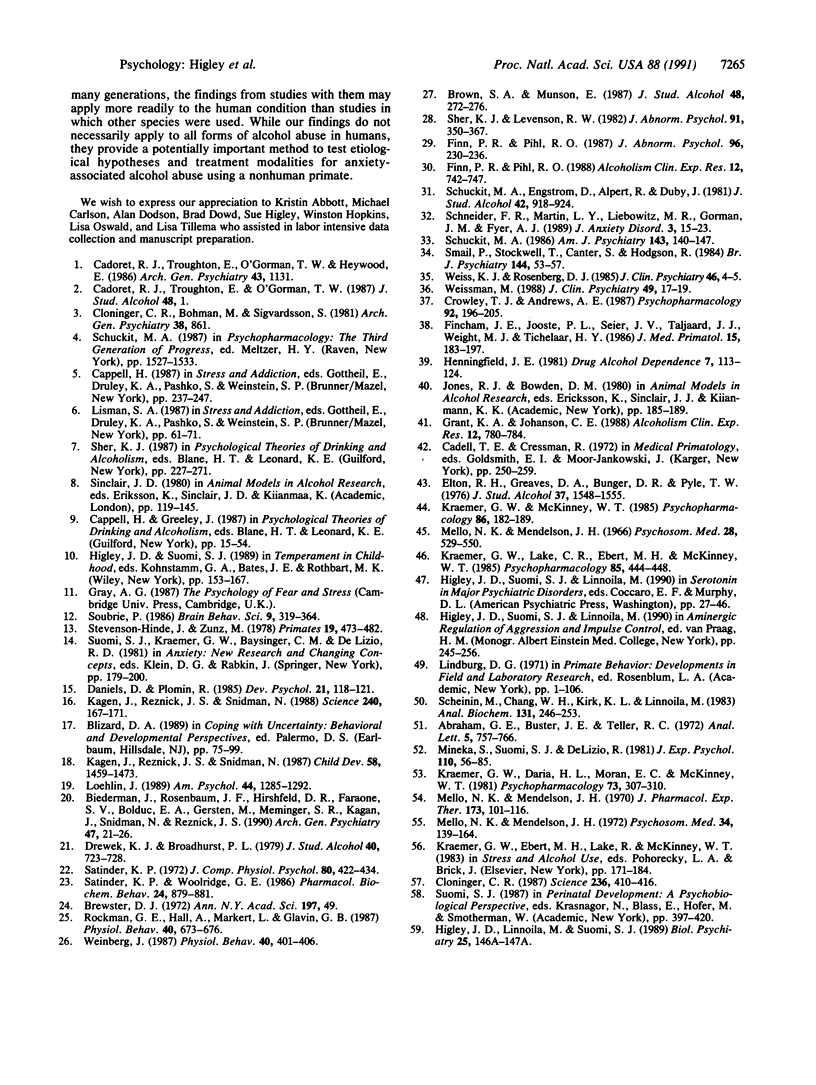Abstract
Twenty-two 50-month-old rhesus monkeys were provided concurrent free access to an aspartame-sweetened 7% ethanol solution and an aspartame-sweetened vehicle before, during, and after social separation. Subjects had been reared for their first 6 months of life either without access to adults but with constant access to age mates (peer reared), a condition producing reduced exploration and increased fear-related behaviors, or as controls with their mothers; thereafter, all subjects received identical treatment. During home-cage periods, for 1 hr each day, 4 days a week, when the ethanol solution and vehicle were freely available, peer-reared subjects consumed significantly more alcohol than mother-reared subjects. When stress was increased via social separation, mother-reared animals increased their alcohol consumption to a level nearly as high as that of peer-reared monkeys. Average individual differences in alcohol consumption were markedly stable over time. In addition, there were strong positive correlations between alcohol consumption and distress behaviors. Biological indices of increased stress, such as plasma cortisol and corticotropin, were higher in peer-reared subjects. Within the peer- and mother-reared groups, these indices were positively correlated with alcohol consumption. The results suggest that early rearing experiences that predispose monkeys to increased fear-related behaviors produce excessive alcohol consumption under normal living conditions. Furthermore, a major challenge such as social separation increases alcohol consumption to levels producing intoxication even in monkeys not particularly vulnerable to stress.
Full text
PDF




Images in this article
Selected References
These references are in PubMed. This may not be the complete list of references from this article.
- Biederman J., Rosenbaum J. F., Hirshfeld D. R., Faraone S. V., Bolduc E. A., Gersten M., Meminger S. R., Kagan J., Snidman N., Reznick J. S. Psychiatric correlates of behavioral inhibition in young children of parents with and without psychiatric disorders. Arch Gen Psychiatry. 1990 Jan;47(1):21–26. doi: 10.1001/archpsyc.1990.01810130023004. [DOI] [PubMed] [Google Scholar]
- Brewster D. J. Ethanol preference in strains of rats selectively bred for behavioral characteristics. Ann N Y Acad Sci. 1972 May 25;197:49–53. doi: 10.1111/j.1749-6632.1972.tb28117.x. [DOI] [PubMed] [Google Scholar]
- Brown S. A., Munson E. Extroversion, anxiety and the perceived effects of alcohol. J Stud Alcohol. 1987 May;48(3):272–276. doi: 10.15288/jsa.1987.48.272. [DOI] [PubMed] [Google Scholar]
- Cadoret R. J., Troughton E., O'Gorman T. W. Genetic and environmental factors in alcohol abuse and antisocial personality. J Stud Alcohol. 1987 Jan;48(1):1–8. doi: 10.15288/jsa.1987.48.1. [DOI] [PubMed] [Google Scholar]
- Cadoret R. J., Troughton E., O'Gorman T. W., Heywood E. An adoption study of genetic and environmental factors in drug abuse. Arch Gen Psychiatry. 1986 Dec;43(12):1131–1136. doi: 10.1001/archpsyc.1986.01800120017004. [DOI] [PubMed] [Google Scholar]
- Cloninger C. R., Bohman M., Sigvardsson S. Inheritance of alcohol abuse. Cross-fostering analysis of adopted men. Arch Gen Psychiatry. 1981 Aug;38(8):861–868. doi: 10.1001/archpsyc.1981.01780330019001. [DOI] [PubMed] [Google Scholar]
- Cloninger C. R. Neurogenetic adaptive mechanisms in alcoholism. Science. 1987 Apr 24;236(4800):410–416. doi: 10.1126/science.2882604. [DOI] [PubMed] [Google Scholar]
- Crowley T. J., Andrews A. E. Alcoholic-like drinking in simian social groups. Psychopharmacology (Berl) 1987;92(2):196–205. doi: 10.1007/BF00177915. [DOI] [PubMed] [Google Scholar]
- Drewek K. J., Broadhurst P. L. Alcohol selection by strains of rats selectively bred for behavior. J Stud Alcohol. 1979 Jul;40(7):723–728. doi: 10.15288/jsa.1979.40.723. [DOI] [PubMed] [Google Scholar]
- Elton R. H., Greaves D. A., Bunger D. R., Pyle T. W. Drinking patterns of pigtailed macaques. J Stud Alcohol. 1976 Nov;37(11):1548–1555. doi: 10.15288/jsa.1976.37.1548. [DOI] [PubMed] [Google Scholar]
- Fincham J. E., Jooste P. L., Seier J. V., Taljaard J. J., Weight M. J., Tichelaar H. Y. Ethanol drinking by vervet monkeys (Cercopithecus pygerethrus): individual responses of juvenile and adult males. J Med Primatol. 1986;15(3):183–197. [PubMed] [Google Scholar]
- Finn P. R., Pihl R. O. Men at high risk for alcoholism: the effect of alcohol on cardiovascular response to unavoidable shock. J Abnorm Psychol. 1987 Aug;96(3):230–236. doi: 10.1037//0021-843x.96.3.230. [DOI] [PubMed] [Google Scholar]
- Finn P. R., Pihl R. O. Risk for alcoholism: a comparison between two different groups of sons of alcoholics on cardiovascular reactivity and sensitivity to alcohol. Alcohol Clin Exp Res. 1988 Dec;12(6):742–747. doi: 10.1111/j.1530-0277.1988.tb01338.x. [DOI] [PubMed] [Google Scholar]
- Grant K. A., Johanson C. E. Oral ethanol self-administration in free-feeding rhesus monkeys. Alcohol Clin Exp Res. 1988 Dec;12(6):780–784. doi: 10.1111/j.1530-0277.1988.tb01345.x. [DOI] [PubMed] [Google Scholar]
- Henningfield J. E., Ator N. A., Griffiths R. R. Establishment and maintenance of oral ethanol self-administration in the baboon. Drug Alcohol Depend. 1981 Apr;7(2):113–124. doi: 10.1016/0376-8716(81)90025-9. [DOI] [PubMed] [Google Scholar]
- Kagan J., Reznick J. S., Snidman N. Biological bases of childhood shyness. Science. 1988 Apr 8;240(4849):167–171. doi: 10.1126/science.3353713. [DOI] [PubMed] [Google Scholar]
- Kagan J., Reznick J. S., Snidman N. The physiology and psychology of behavioral inhibition in children. Child Dev. 1987 Dec;58(6):1459–1473. [PubMed] [Google Scholar]
- Kraemer G. W., Lake C. R., Ebert M. H., McKinney W. T. Effects of alcohol on cerebrospinal fluid norepinephrine in rhesus monkeys. Psychopharmacology (Berl) 1985;85(4):444–448. doi: 10.1007/BF00429662. [DOI] [PubMed] [Google Scholar]
- Kraemer G. W., Lin D. H., Moran E. C., McKinney W. T. Effects of alcohol on the despair response to peer separation in rhesus monkeys. Psychopharmacology (Berl) 1981;73(4):307–310. doi: 10.1007/BF00426455. [DOI] [PubMed] [Google Scholar]
- Kraemer G. W., McKinney W. T. Social separation increases alcohol consumption in rhesus monkeys. Psychopharmacology (Berl) 1985;86(1-2):182–189. doi: 10.1007/BF00431706. [DOI] [PubMed] [Google Scholar]
- Loehlin J. C. Partitioning environmental and genetic contributions to behavioral development. Am Psychol. 1989 Oct;44(10):1285–1292. doi: 10.1037//0003-066x.44.10.1285. [DOI] [PubMed] [Google Scholar]
- Mello N. K., Mendelson J. H. Drinking patterns during work-contingent and noncontingent alcohol acquisition. Psychosom Med. 1972 Mar-Apr;34(2):139–164. doi: 10.1097/00006842-197203000-00007. [DOI] [PubMed] [Google Scholar]
- Mello N. K., Mendelson J. H. Experimentally induced intoxication in alcoholics: a comparison between programed and spontaneous drinking. J Pharmacol Exp Ther. 1970 May;173(1):101–116. [PubMed] [Google Scholar]
- Mineka S., Suomi S. J., DeLizio R. Multiple separations in adolescent monkeys: an opponent-process interpretation. J Exp Psychol Gen. 1981 Mar;110(1):56–85. doi: 10.1037//0096-3445.110.1.56. [DOI] [PubMed] [Google Scholar]
- Rockman G. E., Hall A., Markert L., Glavin G. B. Early weaning effects on voluntary ethanol consumption and stress responsivity in rats. Physiol Behav. 1987;40(5):673–676. doi: 10.1016/0031-9384(87)90116-8. [DOI] [PubMed] [Google Scholar]
- Satinder K. P. Behavior-genetic-dependent self-selection of alcohol in rats. J Comp Physiol Psychol. 1972 Sep;80(3):422–434. doi: 10.1037/h0032979. [DOI] [PubMed] [Google Scholar]
- Satinder K. P., Wooldridge G. E. Emotional reactivity and alcohol preference among genetic crosses of the Maudsley and Roman rats. Pharmacol Biochem Behav. 1986 Apr;24(4):879–881. doi: 10.1016/0091-3057(86)90430-2. [DOI] [PubMed] [Google Scholar]
- Scheinin M., Chang W. H., Kirk K. L., Linnoila M. Simultaneous determination of 3-methoxy-4-hydroxyphenylglycol, 5-hydroxyindoleacetic acid, and homovanillic acid in cerebrospinal fluid with high-performance liquid chromatography using electrochemical detection. Anal Biochem. 1983 May;131(1):246–253. doi: 10.1016/0003-2697(83)90162-8. [DOI] [PubMed] [Google Scholar]
- Schuckit M. A., Engstrom D., Alpert R., Duby J. Differences in muscle-tension response to ethanol in young men with and without family histories of alcoholism. J Stud Alcohol. 1981 Nov;42(11):918–924. doi: 10.15288/jsa.1981.42.918. [DOI] [PubMed] [Google Scholar]
- Schuckit M. A. Genetic and clinical implications of alcoholism and affective disorder. Am J Psychiatry. 1986 Feb;143(2):140–147. doi: 10.1176/ajp.143.2.140. [DOI] [PubMed] [Google Scholar]
- Sher K. J., Levenson R. W. Risk for alcoholism and individual differences in the stress-response-dampening effect of alcohol. J Abnorm Psychol. 1982 Oct;91(5):350–367. doi: 10.1037//0021-843x.91.5.350. [DOI] [PubMed] [Google Scholar]
- Smail P., Stockwell T., Canter S., Hodgson R. Alcohol dependence and phobic anxiety states. I. A prevalence study. Br J Psychiatry. 1984 Jan;144:53–57. doi: 10.1192/bjp.144.1.53. [DOI] [PubMed] [Google Scholar]
- Weinberg J. Effects of early experience on responsiveness to ethanol: a preliminary report. Physiol Behav. 1987;40(3):401–406. doi: 10.1016/0031-9384(87)90068-0. [DOI] [PubMed] [Google Scholar]
- Weissman M. Anxiety and alcoholism. J Clin Psychiatry. 1988 Oct;49 (Suppl):17–19. [PubMed] [Google Scholar]




